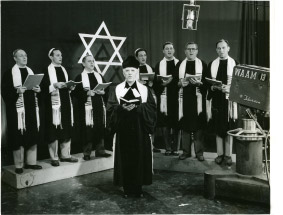The religious response was the emergence of the synagogue as a central locale for Jewish identity. The synagogue became very important. Americanized Orthodox, Conservative and Reform congregations began to build synagogues to be seven-day-a-week locales where Jews could come and congregate to pray, but also to be among their own kind in a Jewish setting. This became known as the synagogue centered movement, what Professor Geoffrey Gurock calls “the phenomenon of you come to play and you stay to pray”. The play aspect could be music, art, theatre, athletics or socializing within the confines of the synagogue, with the idea that you’ll be among Jews and that there would be a crossover from the experiential and recreational into the spiritual.

Another challenge of suburbanization was that houses of Jewish worship could now draw on congregants from miles around. For Reform Jews, who were not opposed to driving on Shabbat or holidays, this was a boon. Orthodox Jews, who would drive only in cases of severe emergencies, built communities within walking distance of synagogues. Conservative Jews, however, had difficulty deciding how to approach this problem; in 1948, the Conservative movement strategically initiated a major departure from tradition. It advocated permitting its congregants to drive to the synagogue on the Sabbath in order to make it more convenient for them to adjust to the realities of American life. This drew the Conservative movement closer to the Reform movement, while increasing solidarity among the Orthodox. With the move to suburbia, the Conservative synagogues with their more liberal approach to Judaism, became the fastest growing synagogue movement in America at that time. Reform Judaism on the other hand, continued to put their main focus on the quest for social justice in American society – and increased its membership, by offering a revised Jewish theology that departed from traditional Torah Judaism.

After World War II, Orthodox Jewish refugees who came to America, arrived with a commitment to Orthodoxy hitherto unseen in America. They came because Europe was destroyed, and they brought with them a sense of cultural superiority, that the Jewish culture was transcendent over American culture. The immigrants who had come earlier were more committed to a balancing act. This added a new vitality to Orthodoxy and slowly began to make an impact upon the larger American Jewish community. One of their major goals was to create a separatist Jewish educational system, which had been a minority movement among Orthodox Jews in the United States prior to the Second World War. They saw that as Jews became more accepted into American society, the need for intensive Jewish education, integrated with secular studies, was needed in order to prevent assimilation and to promote Jewish identity. Led by Rabbi Aaron Kotler who